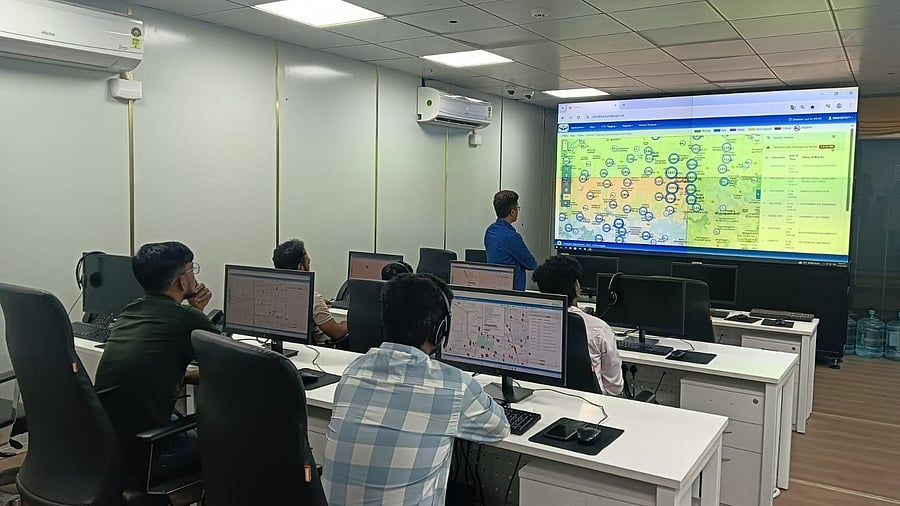
Credit: Special Arrangement
A vast majority of the 500-700 panic button alarms received every day in Bengaluru are non-genuine. The alarms are triggered mostly by students in school buses, curious cab passengers, and drivers testing the device.
In 2019, the government mandated that all public service vehicles (PSVs) in Karnataka, except autos, instal panic alarm buttons and location-tracking devices. So far, about 18% of the six lakh-odd such vehicles have complied, amounting to 1,08,639 as of Wednesday. Around 500-600 vehicles are being fitted with these devices across the state every day.
The calls are monitored at the Command and Control Centre at the Transport Department head office in Shanthinagar. As of Wednesday, 69,433 of the vehicles affixed with these safety devices were old, and 39,211 new, Vijay Mithun Kumar, project manager at the centre, told Metrolife.
The centre operates 24/7, with a total of 30 staffers working in three shifts. A large digital dashboard displays real-time location of clusters of vehicles equipped with these devices. These are also monitored individually on 12 computers. Details about a vehicle, such as its registration number, category, ownership, and speed, are accessible. When an alert is triggered, the team calls the vehicle owner, who then patches in the driver to understand the problem, Kumar explained.
To date, only 17 alerts have been genuine. These mostly involve road rage incidents, such as vehicle collisions, where the parties hit the panic button in the heat of the moment. Except for two or three cases that required police intervention, others got resolved mutually, said Kumar. Other instances in which the panic button alerts helped dispatch timely assistance include a school bus breakdown in a forested area, and an accident on the Electronics City flyover past midnight. The location trackers have helped owners trace their vehicles when drivers went absconding. The alarm is also triggered when vehicles tilt dangerously on elevated roads. No alerts have been reported from ambulances.
Exemption plea
Over 60% of aggregator cabs associated with the Ola Uber Drivers and Owners Association have complied with the rule despite owners’ scepticism, said its president Tanveer Pasha. He asked: “What if a driver doesn’t answer the call after an alert has been sounded? How will help be rushed? The transport department hasn’t engaged with us to clarify the SOP.” However, Kumar said they have been able to contact the drivers so far because of the dual-SIM setup in the location tracker. Though the panic button is connected to the vehicle’s battery, it works even when the engine is switched off, “drawing on residual power”.
Radhakrishna Holla, president of the Karnataka State Travel Operators’ Association, expressed concern about the high installation cost (see box). “Our vehicles already have location trackers, and any alert is sent to our office. So we have requested the government to exempt such vehicles from installing new tracker devices.” The devices are mandated from 12 government-approved manufacturers as they are linked to the command centre for real-time public safety monitoring, explained Kumar.
‘No deadline for compliance’
Umashankar B P, additional commissioner for transport (administration), said vehicle owners have not been given a deadline to instal panic buttons and location trackers. PSVs need to get a fitness certificate every two years, and annually after they cross the eight-year mark. The department is using fitness check as a way to enforce compliance. Without these devices, the vehicle will not be issued a fitness certificate. Existing vehicles must have the devices retrofitted, while new vehicles come with the devices factory-fitted. The new devices in BMTC buses will be installed once tenders are finalised, he said.
How much does it cost?
Vehicle owners bear the cost, and that is another source of annoyance. In the market, the devices together cost between Rs 2,000 and Rs 4,500. But government-approved devices are more expensive — a Vehicle Location Tracking Device (VLTD) costs Rs 5,424, and each emergency button is priced at Rs 325. The minimum number of panic buttons specified depends on the vehicle type. When network connectivity and one year of maintenance (Rs 1,800) is added, the total cost can range between Rs 8,199 and Rs 11,124.